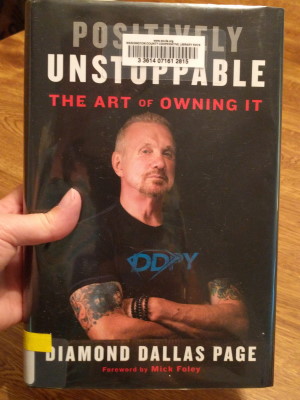
Almost everyone I know has seen the inspiring weight-loss and fitness transformation of Arthur Boorman, a paratrooper with a broken back who was told his case was hopeless. If you haven’t seen the video, go watch it now. I love Boorman’s story. It’s the very definition of “positively unstoppable.” The process he used was DDPY, or DDP Yoga, designed by pro wrestler Diamond Dallas Page.
I’d never heard of Diamond Dallas Page. My only exposure to pro wrestling came from Andy Kaufman’s weird encounters with Jerry Lawler back in the ‘80s. But when I learned that Page developed his recovery program to save his own career—a career he began at age 35—I was captivated.
Few people embrace the opportunity to change any kind of career at age 35. An athletic career? Get real. When Page ruptured two disks in his back, multiple specialists told him he was finished as a wrestler. Instead, he developed his own physical rehabilitation program and resumed competing in less than three months.
I love a comeback.
I couldn't resist
When I saw his book, Positively Unstoppable: The Art of Owning It, on the “New Books” shelf at the library, I grabbed it.
Are you already familiar with his career? If not, check out this book. He describes having the kind of childhood that sends many people down a path of addiction and poverty. He entered adulthood unable to read beyond a third-grade level, due to undiagnosed ADD and dyslexia. He always had athletic leanings, but accidents and illnesses repeatedly demanded that he reinvent himself.
He talks about the importance of being clear about what you want and focusing on action. I appreciated his ongoing refrain that people will want to hold you back, but they can only affect you as much as you allow them to. I was surprised by how much adversity he encountered, both impersonal (like the car accident as a teen) and personal (from other people in various industries). Page talks about how to get your attitude right and how to put “failure” in perspective, so that setbacks don’t permanently derail you.
There are fun mnemonics in here, like SMACKDOWN (specific, measurable, achievable, compatible, keep it going, do it, own it, write it down, now), and there’s lots of profanity. If that kind of thing offends you, this may not be the book for you.
Have I been wrong about hypnosis?
I appreciated that Page didn’t minimize the challenges he faced. He describes the excruciating pain, shame, and confusion he often felt when tackling a new challenge. He admits making mistakes and misapprehensions. He also makes it clear that failure is part of living. We’re never done, and we never get to a point where we won’t struggle and fail. A lot of writers move quickly past the tough stuff, gloss over it, or give the impression that a sunny attitude is all you need. Page doesn’t. I really appreciated his stories of positively unstoppable perseverance.
If you’ve ever heard me speak, you may have heard me say that one reason I love hypnosis is because it makes things easy. Have I changed my mind? Am I now saying, “No pain, no gain”?
I don’t think it’s either/or. I definitely think my own assumptions can make things harder than they need to be. Still, life consists of peaks and valleys, and although I get stronger when I’m on a climb, it also demands more skill than the flatlands. Doing something new means I’m going to stumble, fall, and make mistakes. I might feel frustrated, discouraged, and stupid. I can stay in those feelings and decide that’s the “truth,” or I can respond, “So what? It might be hard now, but I’m doing what’s necessary; I’ll get past this. The payoff is worth it.”
Getting to that point can take minutes, hours, days, weeks, or longer. It depends a lot on the tools we use, the people around us, and our assumptions. Page talks about this in the chapter about owning your environment. He actually uses something I’d call hypnosis with his massage therapist, Terri, to help her move past negative assumptions about her 50th birthday. That’s one of the things I really love about this book: Page is incredibly creative. He’s one of those guys who says, “Yes! I’ll try that!” a lot.
The first eight chapters of the book are biographical. Page writes about his childhood, his marriages, his careers, his successes, his setbacks, and his systems. His conversational writing style is both tough and tender, which I find an inspiring combination. The final three chapters of the book describe his DDP Yoga program (exercises and nutrition) and provide some worksheets for formulating and tracking goals.
There is plenty here for anyone who wants to dig in and create something new in their life, especially if it’s a positively unstoppable attitude and work ethic. Page’s book is both practical and philosophical, and he makes it clear that it’s never too soon or too late to “own it.”